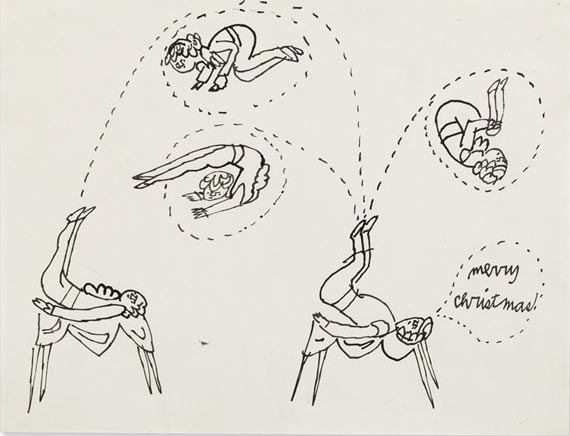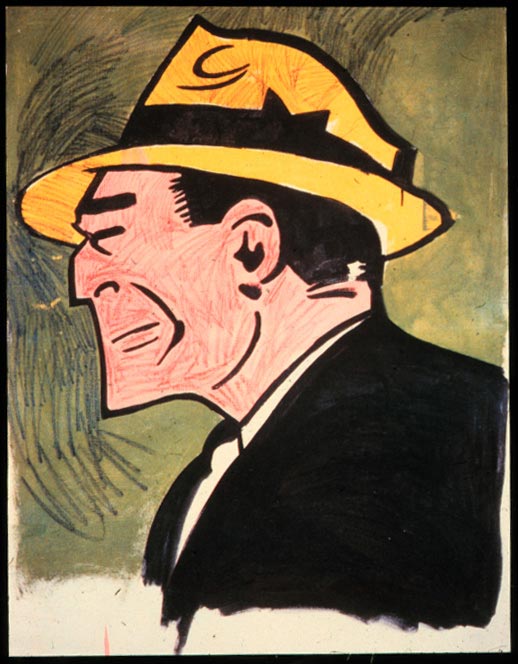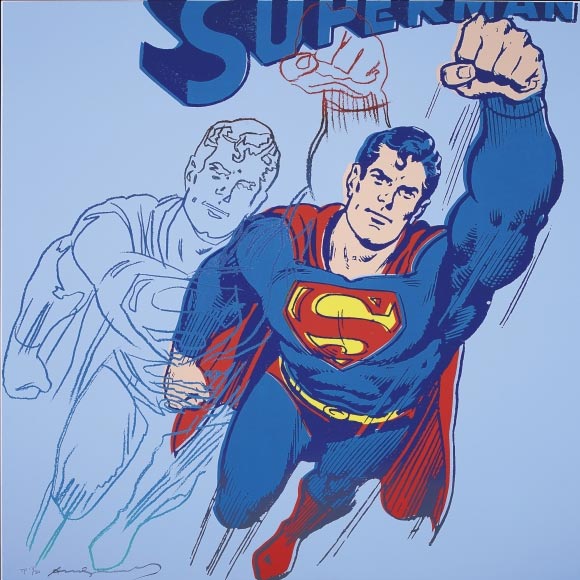Sequential artwork for a Velvet Underground & Nico compilation (1970).
Andy Warhol was one of the most famous and influential artists of the 20th century, along with Pablo Picasso and Salvador Dalí. He made his mark in pop art and became well known for his colorful paintings which bridged the gap between art and advertising. Many feature media celebrities, commercial brands and occasionally comic characters, shown in silkscreen, painted in different colors. Warhol's work exposed the shallowness and campiness of fame and brand recognizability, including his own. Apart from paintings, he also ventured in films, TV shows, plays, books, musical album covers and produced a rock band, The Velvet Underground and Nico. While Warhol never made a comic book, he did paint iconic comic characters and some of his paintings use sequential narratives. One such example can be found on the cover of the compilation album 'The Velvet Underground Featuring Nico' (1970).
Early life and career
He was born in 1928 as Ondrej Warhola in Pittsburgh, Pennsylvania, from Hungarian-Slovakian parents. His father was a coal mine worker. When young Andy was 8 years old, he was struck by the illness St. Vitus' Dance. It forced him to stay in bed, where he spent his time listening to the radio and reading both glamor magazines and comics. Warhol was fascinated with celebrities and iconic imagery, which he replicated in his own drawings. Among his graphic influences were Walt Disney, Chester Gould, E.C. Segar, Bob Kane, Hergé, Joe Shuster and Jerry Siegel. In adulthood, Warhol aspired to become an art teacher and studied commercial art at the Carnegie Institute of Technology in Pittsburgh. He published his first illustrations and designs in the college magazine Cano. After graduation in 1949, Warhol moved to New York City, where he provided graphics for magazines and advertising companies. He also designed album covers and promotional work for RCA Records.
Pen and ink drawing by Andy Warhol from the 1950s.
Pop art
Warhol held his first exhibitions in the 1950s, but was still searching for his own style. In the late 1950s, early 1960s, a new, influential art movement came to the scene: 'popular art', or 'pop art'. The artists made use of pop culture imagery from mass media and reinvented it in a different context. Within this movement, Warhol made several silkscreen paintings, duplicating photographs lifted from magazines, posters and billboards. On each canvas an image is reproduced next to the other in different colors. Warhol's most recurring topics are Hollywood actors (Marilyn Monroe, Elizabeth Taylor, John Wayne), pop stars (Elvis Presley, Mick Jagger), politicians (Mao, Elizabeth II), sports heroes (Muhammad Ali), comic characters (Mickey Mouse, Superman) and advertising products (Campbell's Soup, Coca-Cola). These familiar visuals are put in a bewildering, ironic atmosphere. What were once real-life people and objects, are now reduced to "larger than life" stylized and recolored billboard images. By endlessly duplicating each image Warhol mimics and mocks aggressive mass production. His work therefore blurs the line between advertising and fine art. In further irony, Warhol's paintings had huge marketing appeal. They too were reproduced in mass media, while he himself also grew into an iconic celebrity. As such he became world famous enough to give himself the same trademark "artistic" treatment.
The Factory
Once Andy Warhol's fame rose in the early 1960s, he founded his own company, aptly titled "The Factory". He treated new paintings as mass-produced products. They were made on a steady basis and then sold off at huge prices. Like a real factory boss, Warhol mostly oversaw the production, rather than actively partake in it. He gave directions to his painters and/or approved the end results. His most notable designers and painters were Gerard Malanga, Freddie Herko, Ondine, Ronald Travel, Mary Woronov, Billy Name and Brigid Berlin.
'Dick Tracy', by Andy Warhol.
Fashion, theater and TV
Apart from paintings, Warhol also made his mark in other media. In 1969, he and journalist John Wilcock co-founded the fashion magazine Interview. Warhol also co-wrote a few theatrical plays, such as 'Pork' (1971) and 'Man on the Moon' (1974). Fascinated with television, he lent his name to two talk shows, 'Andy Warhol's TV' (1982) and 'Andy Warhol's Fifteen Minutes' (1986), both broadcast on MTV. Although his name was in the title, he didn't personally interview people, but left this task to others. Sometimes he was present during the interviews, but strictly as a silent observer.
Film
Warhol attracted a huge entourage of eccentric bohemians, gay people, transvestites and drug addicts, whom he named the "Warhol Superstars". He cast these people in several films. His earliest pictures are mere registrations of whatever happens (or doesn't happen) in front of a static camera until the footage runs out. The most infamous of these is 'Empire' (1964), an eight hour and five minutes static shot of the Empire State Building, without any sound and deliberately played at only 16 feet a second to make it even longer. Other, more watchable pictures have an actual narrative, such as 'Andy Warhol's Trash' (1970), 'Andy Warhol's Frankenstein' (1973), 'Andy Warhol's Dracula' (1974) and 'Andy Warhol's Bad' (1977). They became cult classics in the arthouse circuit. But again, although Warhol's name was in the titles, he was not the director, nor a starring actor or screenwriter, only the producer.
Bananas, based on the 'Velvet Underground & Nico' record cover. The iconic banana on the original LP cover could be peeled off like a real banana, revealing the soft pink inside. The phallic symbolism was intentional.
The Velvet Underground & other musical projects
Warhol also launched the career of the avant-garde rock band The Velvet Underground and eccentric German singer Nico. He brought the two together for their collective debut album, 'The Velvet Underground & Nico' (1967) and designed the iconic banana on the album cover. Otherwise he had nothing to do with their music. This proved beneficial for the musicians. Thanks to Warhol's high status, they were allowed to be as taboo-breaking and experimental as they wanted. Thus, together with The Fugs and Frank Zappa's Mothers of Invention, The Velvet Underground became the first known alternative rock band in history. Unfortunately they were a little too ahead of their time. Many listeners were repulsed by their sonic experiments and confrontational lyrics about male prostitution, transvestism, sado-masochism and heroin addiction. Another significant number strongly disliked Nico's atonal voice with thick German accent. The fact that their debut album was produced by Warhol also misled many potential listeners into thinking the painter himself sang on it. As a result, 'The Velvet Underground & Nico' (1967) flopped on its initial release. Only gradually would it pick up a cult following and be vindicated as a milestone in music history.
The band also distanced themselves from Warhol afterwards. The Velvet Underground brought out several other albums, while lead artists Lou Reed, John Cale and Nico all went on to have successful solo careers. The Velvet Underground was influential in alternative rock and very popular in Eastern Europe, where their music was bootlegged behind the Iron Curtain. In 1989, poet Václav Havel became president of Czechoslovakia and brought a peaceful transition to democracy. As a fan of the band, he dubbed his revolution 'The Velvet Revolution'.
Warhol was also hired to design album covers for John Wallowitch's 'This Is John Wallowitch!!!' (1964), The Rolling Stones' 'Sticky Fingers' (1971) and 'Love You Live' (1977), John Cale's 'The Academy in Peril' (1972) and 'Honi Soit' (1981) and Aretha Franklin's 'Aretha' (1986). Of all these, 'Sticky Fingers' became the most notorious. Its cover featured tight trousers with an actual zipper, which could be pulled down.
Public image
By being present in so many different media, Warhol effectively became as recognizable as his work. The "Pope of Pop Art" was an eccentric person who always wore a platinum wig in public. He even trimmed it to give it the appearance of actual hair. He preferred to eat candy and cakes, rather than healthy food. Whenever he met people, he tried to be as bland and superficial as possible. Despite being homosexual, he presented himself as an asexual virgin. During interviews he refused to give any straight or helpful answers, sometimes even preferring to remain silent. The iconic painter published several books, often transcriptions of telephone recordings, complete with all the pointless and uninteresting bits people would usually leave out. The most famous of these are the posthumous 'Andy Warhol Diaries' (1989). Warhol also saved objects from his personal life (newspapers, restaurant bills, food) and stored them away in boxes. Rather than keep his financial wealth in a bank, the suspicious hoarder stashed everything away in his own house.
Self-portrait, from 1963-1964.
Criticism and defense
Already during his lifetime, Warhol was criticized for being a commercial hack who thrived on irony and pointlessness. Most of his art basically references other celebrities and products. Apart from the hollow recognizability, there didn't seem to be any further substance. Warhol happily appeared on a 1981 episode of the sketch show 'Saturday Night Live' and a 1985 episode of the romantic comedy TV series 'The Love Boat'. He also starred in TV commercials for Braniff Air, Diet Coke and Burger King. He didn't seem to mind what high-brow art critics and lovers felt about this. The fact that his studio contributors made the majority of his work was also held against him. Even the rare works that can be directly attributed to his own hands have the appearance of simple, amateurish fan art.
Nevertheless, Warhol wasn't the only artist in history who used assistants and took credit for their achievements. He could hardly be accused of "selling out" either, given that "the Pope of Pop Art" had indulged himself in different mass media from the start. And contrary to most marketing executives, he didn't always play it safe. Warhol loved provoking his audience, as his lengthy monotonous movies, filler books and the shocking music of The Velvet Underground prove. Some of his paintings dare to take a stance by using controversial photographs, like people being executed on the electric chair or African-American civil rights activists being attacked by police dogs. In that sense he really had a message. The artist searched for meaning in his own life too. He was a devout Eastern Orthodox Catholic who went to Mass almost daily. Warhol additionally made several religious-themed paintings, which were only discovered after his death. These are his most personal artistic expressions, which he refused to be made public or be commercialized.
Warhol can also be credited with giving many artists creative freedom, as well as a significant boost to their career. He was a mentor to people like Jean-Michel Basquiat, Julian Schnabel, David Salle, Francesco Clemente, Enzo Cucchi and Keith Haring.
Last but not least, Warhol didn't take himself all that seriously. He was highly self-conscious about all the preposterous media attention he received. In a now legendary quote, he predicted that superficial celebrities would soon become a trend: "In the future everybody will be famous for 15 minutes." Indeed, one can say that Warhol's fascination for the hollowness of celebrity culture was ahead of its time. In the decades that followed, more and more people have become famous. Several only for a short amount of time, almost to the point of being a fad. These instant celebrities can be found on TV, but also on the Internet. Anybody can nowadays crave attention by appearing in a reality TV show or posting their own material online. There is an outburst of blogs, vlogs, personal websites, selfies and social media updates. Countless attention-hungry and opinionated know-it-alls feel obliged to inform everybody about their daily activities and thoughts. Regardless of how amateurish, boring, narcissistic, incorrect or pointless it actually is. And like Warhol predicted: most people's attention rarely lasts longer than a few minutes or seconds. It all makes his art and own public persona seem more topical than ever before.
Final years and death
Unfortunately in 1968, Warhol's fame made him the target of a murder attempt. Feminist activist Valerie Solanas wanted him to adapt a movie script she had written. Yet the painter refused to give the document back, as he wanted to use her for a different project. Out of revenge she shot him, claiming he was a thief who had "too much influence over her". Thanks to a speedy operation, Warhol survived, but was never quite the same again. He had to wear a surgical corset for the rest of his life and frequently suffered pain. A notorious hypochondriac, he was afraid of hospitals and doctor's visits. When Warhol finally underwent an operation for a recurring gallbladder problem in 1987, everything went as planned, but he died in his sleep from postoperative complications. Andy Warhol was buried in his platinum wig, while his funeral was attended by Hollywood celebrities such as Lou Reed, John Cale, Bianca Jagger, Tom Wolfe, Debbie Harry, Grace Jones, Calvin Klein, Timothy Leary, Don Johnson, Keith Haring, Roy Lichtenstein, Robert Mapplethorpe, Liza Minnelli and Yoko Ono.
'Superman' (1981).
Comics
Warhol was a fan of comics since childhood. In the early 1960s, he originally started off making paintings of iconic comic book characters: Chester Gould's 'Dick Tracy' (1960), Elzie Segar's 'Popeye' (1961), Ernie Bushmiller's 'Nancy' (1961) and Jerry Siegel and Joe Shuster's 'Superman' (1960). But he soon found out that another pop artist, Roy Lichtenstein, was already doing the same thing, so he shifted to different topics. Only in 1981 did he make two comic-themed paintings again, namely 'Mickey Mouse' (1981) and another 'Superman' (1981).
While Warhol never drew a comic strip or book, some of his album cover designs for The Velvet Underground have sequential illustrations. Inside the sleeve of 'The Velvet Underground & Nico' (1967), the iconic banana from the front cover is peeled in 12 consecutive images. The phallic shape of the banana and the peeling process bring up intentional sexual connotations. Similar innuendo in a pantomime comic format can be found on Warhol's cover for the compilation album 'The Velvet Underground Featuring Nico' (1970). The comic depicts a pair of lips taking a sip from a Coca Cola bottle through a straw. The red lipstick and the sucking gesture resemble somebody giving fellatio.
In 1964, Warhol directed a low-budget film named 'Batman Dracula', without permission of DC Comics, nor Bob Kane. It can be considered the first Batman "fan film" in history, as well as the first to show a more campy version of the franchise, two years before the TV series starring Adam West went on the air. In 1967, Warhol and singer Nico dressed up as Robin and Batman for a publicity picture. Warhol also once said that Alfred E. Neuman, the mascot of Mad Magazine designed by Norman Mingo, gave him "a love for people with big ears". On 27 April 1972, the world famous painter also met Hergé, creator of 'Tintin', who was visiting New York City. Warhol considered Hergé "more than a comic artist" and a huge influence on his work, "almost as much as Walt Disney". He specifically praised his "great political and satirical dimensions". Warhol showed Hergé around in The Factory, while the comic artist gave him a signed copy of 'Tintin in Tibet' afterwards. In 1977, Hergé commissioned Warhol to make a series of silkscreen paintings, immortalizing the Belgian comic artist's face, rather than Tintin's. Hergé and Warhol met again two years later, this time during a 'Tintin'-themed exhibition in the Palace of Fine Arts in Brussels.
Legacy & influence
Andy Warhol remains an important and groundbreaking figure in 20th-century art. His work has influenced several artists, including Guy Peellaert, Jacques Ristorcelli, Graziano Origa, Peter Haars, Jean Teulé, Gal (Gerard Alsteens), George Kuchar, Derek Boshier, Herr Seele and Ismael Álvarez. Many artists in Warhol's wake have also made iconoclastic, ironic, post-modern or downright pornographic reinterpretations of famous people or comic and cartoon characters, usually by taking a photograph or publicity art, adding splashed out colors and ironic commentary. Examples are Jan Bucquoy, Peter Klashorst, Gary Panter and Kenny Scharf.
On David Bowie's album 'Hunky Dory' (1971), one track is titled 'Andy Warhol'. Bowie would later portray the artist in Julian Schnabel's biopic film 'Basquiat' (1996). Lou Reed and John Cale recorded a tribute album to Warhol, callled 'Songs For Drella' (1989). Statues of Warhol can be found in Bratislava, Slovakia, and at Union Square in New York City. In 1988, an asteroid was named after him. In 2002, the Belgian electronica band 2 Many DJ's brought out their album 'As Heard on Radio Soulwax, Pt. 2', a collection of versatile mashups and samples of well-known and more obscure pop songs. One of these songs was The Velvet Underground's 'Waiting For The Man'. When 2 Many DJ's made an animated music video to be played as visual entertainment during live performances, they animated the mouth from the sleeve of 'The Velvet Underground Featuring Nico'.
Warhol inspired no less than four graphic novels, like 'Warhol Para Principantes' ('Warhol for Beginners', Ediciones Era Naciente, 2001) by Santiago Rial Ungaro and Liniers. Secondly, there is 'Milestones of Art: Andy Warhol: The Factory' (Rakuten Kobo, 2013) by Willi Bloess and Annette Schulze-Kremer. The third title is 'Becoming Andy Warhol' (2016) by Pierce Hargan and Nick Bertozzi. And in 2018 Dutch artist Typex published 'Andy, Feitelijke Fictie'.









